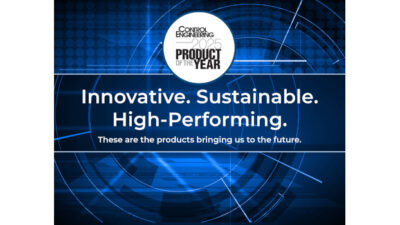Selecting instrumentation for a new or revised process can be daunting, especially if it involves unfamiliar areas. Someone experienced in measuring flow or pressure may find temperature sensors a challenge. When faced with a new situation, how should one begin the process? Choosing instrumentation begins with a careful analysis of the process and control objectives.
AT A GLANCE
Analyze your process
Understand accuracy ratings
Supplier comparability
Functionality options
Sidebars: Sample process instrumentation Range vs. accuracy: which counts more?
Selecting instrumentation for a new or revised process can be daunting, especially if it involves unfamiliar areas. Someone experienced in measuring flow or pressure may find temperature sensors a challenge. When faced with a new situation, how should one begin the process?
Choosing instrumentation begins with a careful analysis of the process and control objectives. Each measurement point has to have a purpose in the larger control scheme. If this purpose is vague, it will be easy to choose the wrong type of device. Too sophisticated a device simply wastes money while too simple a device can give inadequate or even wrong information. Work through the process diagram point by point, and ask the following questions at each:
• What is the variable and relevant unit of measure? (Pressure, temperature, etc.)
• What is the normal operating range when the process is working properly? If the process is new, or still in the design phase, this question can be more difficult to answer than it sounds.
• What is the abnormal range the system could see in an upset condition? How much must the range of the instruments be extended for their own protection? The need to provide a high level of protection from spikes will degrade the ability to be accurate.
• How precise does the measurement have to be? This merits particular thought in that it has a major effect on the cost of the devices.
• Are there functions the unit should perform beyond providing a reading?
“Rarely do you have a process that runs at extremes,” says system integrator Greg Ferro, AmeriChem Systems. “They usually have a narrow band of operation, and you choose devices appropriate to that. Of course, sometimes engineers can’t predict what the real world is going to be. It happens more often than you’d think. If the customer says to design a system to handle 80 gallons per minute and then you find out that they’ll really be running 8, well, then you have a problem.” Choosing a suitable range for instruments is just as critical as accuracy in that the two are virtually always directly linked. Accuracy is frequently expressed as a percentage of the full scale or a turn-down ratio. Operating at the either extreme of the scale sacrifices accuracy, so it is important to understand how the manufacturer defines the best range. The gage sidebar illustrates this point.
The PID sidebar illustrates a simple process diagram with its supporting instrumentation. The caption goes into greater detail of the placement and purpose of each. Once the purpose and functional parameters are set for each device, the next step is to choose a specific manufacturer and model.
How to express accuracy
When an instrument provides a measurement, it is an approximation in that no device is ever absolutely accurate. There will always be some element of error between the reading and ideal value. As a practical matter, the engineer’s objective is to reduce this error so it is negligible in the process context. The degree of deviation between the reading and ideal is the accuracy rating. The range falling between the tolerance’s upper and lower limits is the error band.
According to the Instrumentation, Systems, and Automation Society (ISA), there are five ways to express an accuracy rating:
In terms of the measured variable alone, such as 100 psi,
A percentage of span or scale: a 0-500 psi gage that is
A percentage of the upper range value. (Identical to no. 2 if the scale begins at 0.)
A percentage of scale length, used where the scale does not begin at 0, as can be the case with temperature sensors: 100-200 °C.
A percentage of actual output reading: a 0-100 psi gage is rated at 1% of the actual reading. (That means at 10 it can only be
Most instruments use methods 2, 3, or 4, or some combination, and express accuracy relative to the range or upper limit. Range is linked to accuracy in one way or another for virtually all types of instrumentation.
One size does not fit all
Since range and accuracy are so closely related, choosing an appropriately ranged device is just as important as the right accuracy rating. Plant engineers have a long standing rule of thumb that says gages and other instruments should be ranged so that the normal operating reading is about two-thirds of the full scale. While this dates from the days of mechanical, analog devices, it is still good advice.
Instruments are rarely perfectly linear. Linearity is defined as the closeness of an actual measurement curve to a specified straight line. There are areas in a sensor or device’s measuring span that are better than others, typically losing accuracy toward the low end. Consequently, some manufacturers describe accuracy in terms of a turndown ratio from the upper limit. (Turndown ratio = maximum flow / minimum flow) For example, accuracy can be expressed as a percentage of the upper limit over a turndown ratio of 4:1. This means the accuracy rating only applies in the upper three-quarters of the scale. The lowest quadrant will have a different, probably higher, error rating.
Other types of instrumentation have peculiar characteristics that do not fall under any of these approaches but calculate a value based on a series of variables related to the specific combination of sensing technology, sensor device, and transmitter. Both process and environmental factors can be involved. Generally, such instruments are very high precision and their selection involves careful analysis and consultation for specific applications.
Since instrumentation suppliers endeavor to make their products appear in the best light, they tend to put specifications in terms that compliment a specific model or family. This gets confusing when each supplier specifies performance using different terminology, applies different meanings to the same terms, or disconnects related factors. Many such inconsistencies are in specification presentations, according to David W. Spitzer, author of “Industrial Flow Measurement, 3rd Edition” (ISA). “In reviewing the technical data from about 60 suppliers of non-contact level measuring devices, I found about 30 variations of how to describe accuracy,” he observed.
“We often have to deal with errors of omission because suppliers might not tell you everything–or they might not tell you everything at the same time. For example, the accuracy of a flowmeter might be plus or minus 0.5%. It might also have a turndown ratio of 1000:1. What the supplier did not tell you,” Spitzer says, “is that the instrument cannot do both at the same time. Further investigation would reveal that plus or minus 0.5% only applies over a turndown ratio of perhaps 25:1. Another accuracy specification applies below 4% of flow.”
What other factors matter?
Accuracy can be influenced by ambient or process conditions. For example, a flowmeter is most accurate at a specific temperature. If the temperature of the process fluid or the ambient conditions change, output may deviate even though the flow is the same. Worst case, such a change can be greater than the allowable error band for the device. Sophisticated devices are often designed to monitor these external influences and correct the key variable automatically.
A careful examination of a supplier’s technical specifications may provide correction factors for such external effects, or at least acknowledge that accuracy is based on a certain set of ideal conditions. If this is unclear, it’s best to ask.
Instrumentation selections
Once process needs are clearly defined for function, accuracy, and ranging, it’s time to choose specific suppliers and items. In the absence of a directive to choose one vendor, beginning from scratch can be a major undertaking.
Robert Mapleston, marketing communication manager, ABB Instrumentation, sees this situation frequently. “Sales people are still very important,” he notes. “Customers like to do the initial phases of the research, so you have to give information on-line so they can do their homework before they phone. Then they’ll talk to a rep and say, ‘I’m thinking of using this pressure gage for this application.’”
Instrumentation quality has improved in all areas and price ranges. This has moved the selection process away from splitting hairs over accuracy to areas of functionality and reliability. ABB’s Mapleston observes, “The market has changed over the way it was 15 years ago. Back then it was all about features and performance. Now the playing field is leveler, and people are looking for different things. Most of them have fewer people in maintenance, so that influences their thinking. How can they get the job done? They want things that are more robust. Easy maintenance. Simpler to configure. And, of course, low cost.”
Scott Saunders, VP sales & marketing for Moore Industries, sounds a cautionary note, “It’s true that manufacturing techniques and components available now are more consistent. But you have to look at it in the long term. Some low cost sensors and transmitters start to drift and lose repeatability. They don’t stand up over time.”
Besides long term performance, Saunders has seen the effects of less sophisticated protective features. “A worker using a walkie-talkie close to a poorly filtered thermocouple transmitter can cause RFI that the system will read as a temperature spike. It could trip an alarm and shut down the process.”
Given the degree of interdependence and instrumentation networking, it is important to keep the whole process in mind. “You have to understand how critical the application is. What are you trying to measure?” asks Natalie Strehlke, product manager, Rosemount Division of Emerson Process Management.
“Our focus as a company has moved from product to applications. The customer doesn’t just want a process variable, it’s about controlling the plant. They ask us, ‘what else can this thing do?’ Customers want performance, yes, but also reliability and stability. Reliability says how much maintenance time I’ll have to spend. Stability means I don’t have to go and recalibrate something as frequently.”
Which features count?
If the accuracy available in current instrumentation is greater than most processes need, what should be the points to help distinguish between competitors?
• Functionality—What can a device do besides provide a process variable?
• Ease of programming—Can your operators work with this system, or will they need additional training?
• Networking flexibility—This device may be adequate for today, but are there plans to upgrade a fieldbus or DCS?
• Self-diagnostic routines—What conditions, besides the given process variable, should this device be able to measure? What error messages or self-condition monitoring do you want?
• Stability—How often does a device require calibration? Are the schedules for your current design instrumentation based on mechanical and analog devices? If so, you are probably calibrating too often. Factory calibrated devices can go into service immediately and can operate years before they need to be rechecked. This reduces maintenance costs.
• Reliability—How maintenance intensive is a specific device? Will it be easy to reach and service, or in a difficult or dangerous place? Is low initial cost worth the time to deal with an unreliable piece of instrumentation? Objective information outside of your own experience can be difficult to obtain.
• Scalability—If you update your fieldbus or network system, will you need to replace devices? Many manufacturers offer modular designs that allow upgrades as needs change.
• In-plant experience—What products are you already using? Has the experience been positive? If you have a history with a specific manufacturer, you already know its characteristics, have relationships with sales people, and have parts on the shelf. Bottom line, you already have an investment worth maintaining.
Saunders says, “The best compliment you can get as an instrumentation vendor is when a customer says, ‘I put your sensors in, and I don’t have to worry about them.’”
Related reading
Rx for instrumentation
Instrumentation Selection: Getting it Right the First Time
Sample process instrumentation
This simple chemical mixing process illustrates instrumentation selection in basic terms. Here water is added to a chemical reagent to produce a slightly diluted final product. Changing process conditions require the mixing ratio to vary within a narrow range. All flow and pressure transducers transmit their readings to a PLC and most have displays on the instrument for immediate reading.
A P&ID is a helpful way to organize your process analysis and instrumentation selection.
The reagent moves through one of the pumps and a check valve to an electro-pneumatically operated control valve. The liquid passes through a magnetic flowmeter, chosen for its unobstructed flow and high accuracy to a pressure transducer just prior to the mixing point.
The water moves first through a strainer. A differential pressure sensor straddles the strainer to monitor its condition. If the differential reading exceeds a specific set-point, an alarm trips to signal maintenance that it has become too full of debris. After passing through check valves and pump, a control valve modulates the water flow to maintain the desired proportion with the reagent. After the control valve, a pressure transducer and vortex flowmeter measure its throughput. The vortex sensor is simple and inexpensive for this less critical measurement point.
After the two components mix, a pressure transducer monitors the combined stream just ahead of a static mixer. Before passing to the storage tank, the final volume is measured using an orifice plate and differential pressure transducer. This measurement is checked against the two feedstock flows to verify correct final volume. All these factors are related by the PLC to modulate the control valves for the desired volume and dilution ratio.
Range vs. accuracy: which counts more?
Your task is to measure liquid pressure in a pipe which is typically 40 psi. You have two gages with these specs:
Looks can be deceiving. Make sure you understand all the specifications.
Gage 1: 0-300 psi, 3A grade (
Gage 2: 0-100 psi, 2A grade (
The first one is better because it’s twice as accurate, right? Yes, that’s true, but in this case it’s wrong for the application. Gage 1 can be
The key is to choose a device with a range as close to the typical operating pressure as possible while still allowing some protective cushion for spikes. A 0-50 psi, 2A gage would give an even more accurate reading if you are certain that it will not be subjected to pressure spikes beyond its upper limit.
Accuracy measurement, by itself, is only one variable of the selection equation. Range, in this example, is just as important.



